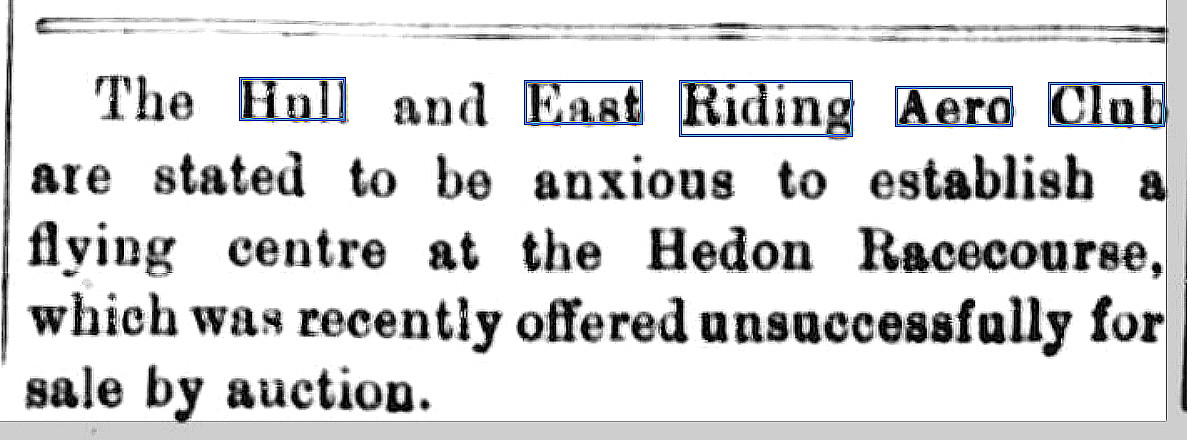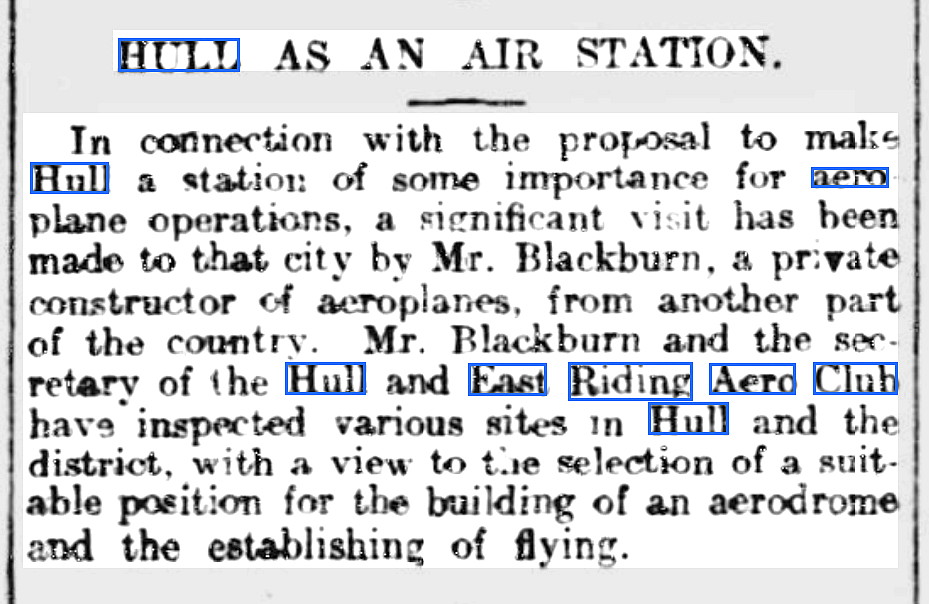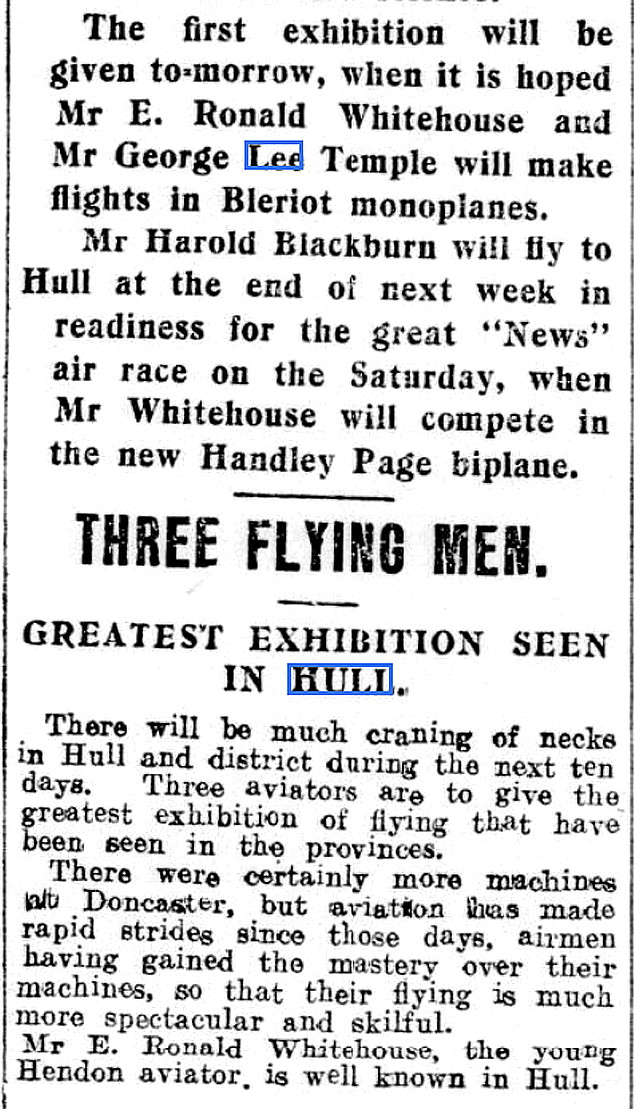Goddard Avenue in Hull
GODDARD AVENUE, HULL: Temporary aerodrome (Aka NEWLAND PARK)
Up until recently Mike Holder and myself were perfectly happy with this listing. Then Mike Holder came across some information about this site being used as a 'big' venue in October 1913! So, he decided to investigate further. Without much if any doubt it was the Hull and East Riding Aero Club who were leading the campaign to have a permanent aerodrome established near Hull.
The notice was published in the Beverley and East Riding Recorder on the 31st May 1913. The article was published in the Lincolnshire Echo on the 29th May. The instincts of the Hull and East Riding Aero Club turned out to be spot on. HEADON later becoming the regional airport for HULL in the 1930s.
THE FLYING CARNIVAL AT THE OCTOBER FAIR - 9th to 18th OCTOBER 1913
Article One was published in the Yorkshire Post and Leeds Intelligencer on the 25th Sepember 1913. Although it appears that the Hull and East Riding Aero Club had been using this location, (amongst others perhaps?), Article One explains that it was the Hull Aviation Company that had made all the arrangements.
It does seem that the proposed flight from HENDON to HULL never came about. Possibly the newly formed Hull Aviation Company did not have the knowledge and expertise to transform a proposal into a reality? No doubt we shall never know? Experienced pilots with reliable machines were available.
THE DEED IS READY TO BE DONE!
This Article Two, in four parts, was published in the Hull Daily News on the 8th October 1913, the day before the 'Flying Carnival' commenced.
A QUICK UPDATE OF THE PROCEEDINGS
Article Three in two parts was published in the Yorkshire Post and Leeds Intelligencer on the 13th October 1913.
SOME EXTRA ITEMS
This advert was also published in the Hull Daily News on the 8th October.
The two photos of Mr George Lee Temple seated on his Blériot were published in the Hull Daily News on the 15th October. Article Four was published in the Yorkshire Post and Leeds Intelligencer on the 16th October 1913.
"COLLAPSE OF AIR RACE"
This Article Five in two parts was published in the Yorkshire Post and Leeds Intelligencer on the 20th October. It might seem astonishing that the organisers had absolutey no idea whatsover about the nature of an air race conducted over a reasonably long distance.
Lacking any comprehension that once a competing aircraft has taken off - it very quickly disappears - out of sight until the very end......if it makes it! It would be hard, difficult or indeed impossible to try and imagine a more utterley stultifying event to close with. (Nothing happening - nothing to see). I rather suspect that the organisers, having no idea about how to arrange such an event, especially from the point of view of spectators, and having heard about the considerable amount of publicity generated by major air races, conned themselves into thinking that this was "A very good idea indeed."
It had in fact already been fully appreciated even a few years before, that, as a general rule, a single air race event needs to be staged around a closed circuit keeping as close as possible to not just the aerodrome, but especially the spectators.
THE 1921 VENUE
Operated by: Berkshire Aviation
Location: About 1.5nm NW to NNW of Hull city centre
Period of operation: 25th July to the 3rd August 1921
A MICHAEL T HOLDER GALLERY
We have Mike Holder, a great friend of this 'Guide', to thank for pinning down this venue.
The advert was published in the Hull Daily Mail on the 22nd July 1921.
Note; The local view and area view are from my Google Earth © derived database.
NOTES: There are two aspects which I have found interesting. The first being just how close to built up areas those early displays were. Needless to say our towns and cities are much larger than they were then, but even so, there appears to have been little if any concern regarding the reliability of single engine aircraft flying low over built up areas. This said, there are hardly any accounts, including before WW1, of engine failure over built up areas causing any significan damage to property - let alone injury to third parties. Indeed, I am surprised to find just how reliable those early 'thumpers' were.
The second aspect is that, as often as not, these early post WW1 flying displays stayed for several days. Clearly doing so because there was enough custom to be found. The prospect of being able to obtain joy-rides, including basic aerobatics for the braver souls, often enjoyed by women too, was certainly a legacy brought about by the often heroic air battles fought during the 'Great War', which had been highly publicised.
Wind the clock forward around ten years and the picture had changed dramatically. Even the largest touring concerns, with fabulous novelty displays, with a dozen or more aircraft, usually stayed one day, or at most two, at the bigger venues. That era had pretty much finished by 1936. Perhaps hardly surprising, not least because the 'war clouds' were once again gathering across western Europe.
We'd love to hear from you, so please scroll down to leave a comment!
Leave a comment ...
Copyright (c) UK Airfield Guide





































